I am implementing the Francis double step QR Iteration algorithm using the notes and psuedocode from lecture https://people.inf.ethz.ch/arbenz/ewp/Lnotes/chapter4.pdf - Algorithm 4.5
The psuedocode is provided in Matlab I believe. 
Below is the implementation of my code.
# compute upper hessenberg form of matrix
def hessenberg(A):
m,n = A.shape
H = A.astype(np.float64)
for k in range(n-2):
x = H[k+1:, k]
v = np.concatenate([np.array([np.sign(x[0]) * np.linalg.norm(x)]), x[1:]])
v = v / np.linalg.norm(v)
H[k+1:, k:] -= 2 * np.outer(v, np.dot(v, H[k+1:, k:]))
H[:, k+1:] -= 2 * np.outer(np.dot(H[:, k+1:], v), v)
return(H)
# compute first three elements of M
def first_three_M(T,s,t):
x = T[0, 0]**2 + T[0, 1] * T[1, 0] - s * T[0, 0] + t
y = T[1, 0] * (T[0, 0] + T[1, 1] - s)
z = T[1, 0] * T[2, 1]
return(x,y,z)
# householder reflection
def householder_reflection_step(x_1):
v = x_1[0] + np.sign(x_1[0]) * np.linalg.norm(x_1)
v = v / np.linalg.norm(v)
P = np.eye(3) - 2 * np.outer(v, v)
return(P)
# update elements of M
def update_M(T,k,p):
x = T[k+1, k]
y = T[k+2, k]
if k < p - 3:
z = T[k+3, k]
else:
z = 0
return(x,y,z)
# givens rotation
def givens_step(T,x_2,x,y,p,q,n):
# calculate c and s
c = x / np.sqrt(x**2 + y**2)
s = -y / np.sqrt(x**2 + y**2)
P = np.array([[c, s], [-s, c]])
T[q-1:p, p-3:n] = P.T @ T[q-1:p, p-3:n]
T[0:p, p-2:p] = T[0:p, p-2:p] @ P
return(T)
# deflation step
def deflation_step(T,p,q,epsilon):
if abs(T[p-1, p-2]) < epsilon * (abs(T[p-2, p-2]) + abs(T[p-1, p-1])):
T[p-1, p-2] = 0
p = p - 1
q = p - 1
elif abs(T[p-2, p-3]) < epsilon * (abs(T[p-3, p-3]) + abs(T[p-2, p-2])):
T[p-2, p-3] = 0
p = p - 2
q = p - 1
return(T,p,q)
# francis qr step
def francis_step(H, epsilon=0.90):
n = H.shape[0]
T = H.copy().astype(np.float64)
p = n - 1
while p > 2:
q = p - 1
s = T[q, q] + T[p, p]
t = T[q, q] * T[p, p] - T[q, p] * T[p, q]
# Compute M
x,y,z = first_three_M(T,s,t)
x_1 = np.transpose([[x], [y], [z]])
# Bulge chasing
for k in range(p - 3):
# Compute Householder reflector
P = householder_reflection_step(x_1)
r = max(1, k-1)
T[k:k+3, r:] = P.T @ T[k:k+3, r:]
r = min(k + 3, p)
T[0:r, k:k+3] = T[0:r, k:k+3] @ P
# Update M
x,y,z = update_M(T,k,p)
x_2 = np.transpose([[x], [y]])
# Compute Givens rotation
T = givens_step(T,x_2,x,y,p,q,n)
# Check for convergence
T,p,q = deflation_step(T,p,q,epsilon)
return(T)
# francis qr iteration
def francis_qr_iteration(A):
m,n = A.shape
H = hessenberg(A)
eigvals = []
iters = 0
max_iters = 100
while iters<max_iters:
# Perform Francis step
T = francis_step(H)
eigvals.append(np.diag(T))
iters+=1
return(eigvals)
# for quick testing
A = np.array([[2, 2, 3, 4, 2],
[1, 2, 4, 2, 3],
[4, 1, 2, 1, 5],
[5, 2, 5, 2, 1],
[3, 6, 3, 1, 4]])
eigenvals = francis_qr_iteration(A)
#comparing our method to scipy - final eigvals obtained
print(len(eigenvals))
print(sorted(eigenvals[-1]))
print(sorted(scipy.linalg.eig(A)[0].real))
And this is the output I am getting.
100
[-4.421235127393854, -0.909209110641351, -0.8342390091346807, 3.7552499102751575, 8.215454029003958]
[-3.0411228516834217, -1.143605409373778, -1.143605409373778, 3.325396565009845, 14.002937105421134]
The matrix T is not changing and hence it does not converge to the Schur form through which I can obtain the eigenvalues by using np.diag(T). I believe the error is coming either from the Givens rotation step or the Householder reflection step. It could be an indexing issue since I tried to work in python using matlab psuedocode. Please let me know where I am going wrong so I can improve the code and make it converge.